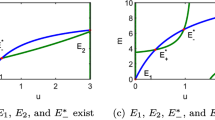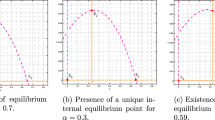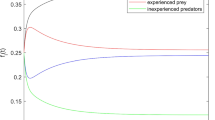Abstract
This work aims to study a population-dispersal dynamics for predator–prey interactions in a two patch environment with strong Allee effect among prey species in both patches. It is assumed that the prey species are movable and their dispersal between patches is directed from lower fitness to the higher fitness patch (exhibiting balanced dispersal). Existence and stability criterion of the interior equilibrium point of the system is analyzed in presence as well as in absence of dispersal speed. It has been observed that Allee threshold takes an important role to destabilize the system while the prey individuals evolve in their own patches independently. Moreover dispersal cannot destabilize populations at the interior equilibrium, i.e., if a predator–prey equilibrium without dispersal is in stable state then this situation cannot be destabilized when prey species move between two patches. Numerical simulations using MATLAB validate the analytical results. The occurrence of transcritical as well as Hopf bifurcation has also been reported.





























Similar content being viewed by others
References
Hassel MP, May RM (1973) Stability in insect host-parasite models. J Anim Ecol 42:693–726
Hassel MP (1984) Parasitism in patchy environments: inverse density dependence can be stabilizing. IMA J Math Appl Med Biol 1:123–133
Ives R (1992) Continuous-time models of host-parasitoid interactions. Am Nat 140:1–29
Reeve J (1988) Environmental variability, migration and persistence in host-parasitoid systems. Am Nat 132:810–836
Mchich R, Auger PM, Bravo De La Parra R, Raissi N (2002) Dynamics of a fishery on two fishing zones with fish stock dependent migrations: aggregation and control. Ecol Model 158:51–62
Gadgil M (1971) Dispersal: population consequences and evolution. Ecology 52:253–261
Hamilton WD, May RM (1977) Dispersal in stable habitats. Nature 269:578–581
Comins H, Hamilton W, May R (1980) Evolutionarily stable dispersal strategies. J Theor Biol 82:205–230
Hastings A (1983) Can spatial variation alone lead to selection for dispersal? Theor Popul Biol 24:244–251
Holt RD (1985) Population dynamics in two-patch environments: some anomalous consequences of an optimal habitat distribution. Theor Popul Biol 28:181–208
McPeek MA, Holt RD (1992) The evolution of dispersal in spatially and temporally varying environments. Am Nat 140:1010–1027
Holt RD, McPeek MA (1996) Chaotic population dynamics favors the evolution of dispersal. Am Nat 148:709–718
Amarasekare P (1998) Interactions between local dynamics and dispersal: insights from single species models. Theor Popul Biol 53:44–59
Diffendorfer JE (1998) Testing models of source-sink dynamics and balanced dispersal. Oikos 81:417–433
Dieckmann U, O’Hara B, Weisser W (1999) The evolutionary ecology of dispersal. Trends Ecol Evol 14:88–90
Ferriere R, Belthoff JR, Olivieri I, Krackow S (2000) Evolving dispersal: where to go next? Trends Ecol Evol 15:5–7
Holt RD, Barfield M (2001) On the relationship between the idealfree distribution and the evolution of dispersal. In: Danchin JCE, Dhondt A, Nichols J (eds) Dispersal. Oxford University Press, New York, pp 83–95
Donahue MJ, Holyoak M, Feng C (2003) Patterns of dispersal and dynamics among habitat patches varying in quality. Am Nat 162:302–317
Padrón V, Trevisan MC (2006) Environmentally induced dispersal under heterogeneous logistic growth. Math Biosci 199:160–174
Cantrell RS, Cosner C, DeAngelis DL, Padron V (2007) The ideal free distribution as an evolutionarily stable strategy. J Biol Dyn 1:249–271
Kang Y, Sasmal SK, Messan K (2017) A two-patch prey–predator model with predator dispersal driven by the predation strength. Math Biosci Eng 14(4):843–880
Pal D, Samanta GP (2018) Effects of dispersal speed and strong Allee effect on stability of a two-patch predator–prey model. Int J Dyn Control (2018). https://doi.org/10.1007/s40435-018-0407-1
Levin SA (1974) Dispersion and population interactions. Am Nat 108:207–228
Hassell MP, Comins HN, May RM (1991) Spatial structure and chaos in insect population dynamics. Nature 353:255–258
Bascompte J, Soleé RV (1995) Spatially induced bifurcations in single-species population dynamics. J Anim Ecol 63:256–265
Ruxton GD (1996) Density-dependent migration and stability in a system of linked populations. Bull Math Biol 58:643–660
Tilman D, Kareiva P (1997) Spatial ecology: the role of space in population dynamics and interspecific interactions. Monographs in population biology, vol 30. Princeton University Press, Princeton
Hanski IA, Gilpin ME (1997) Metapopulation biology: ecology, genetics, and evolution. Academic Press, San Diego
Rohani P, Ruxton GD (1999) Dispersal and stability in metapopulations. IMA J Math Appl Med Biol 16:297–306
Hanski I (1999) Metapopulation ecology. Oxford University Press, New York
Fretwell DS, Lucas HL (1969) On territorial behavior and other factors influencing habitat distribution in birds. Acta Biotheor 19:16–32
Cressman R, Krivan V (2006) Migration dynamics for the ideal free distribution. Am Nat 168:384–397
Krivan V, Sirot E (2002) Habitats election by two competing species in a two-habitat environment. Am Nat 160:214–234
Murdoch WW, Briggs CJ, Nisbet RM (2003) Consumer-resource dynamics. Princeton University Press, Princeton
Abrams PA, Cressman R, Krivan V (2007) The role of behavioral dynamics in determining the patch distributions of interacting species. Am Nat 169:505–518
Abrams PA (2010) Implications of flexible foraging for interspecific interactions: lessons from simple models. Funct Ecol 24:7–17
Andersen V, Gubanova A, Nival P, Ruellet T (2001) Zooplankton community during the transition from spring bloom to oligotrophy in the open NW Mediterranean and effects of wind events. 2. Vertical distributions and migrations. J Plankton Res 23:243–261
Slusarczyck M, Dawidowicz P, Rygielska E (2005) Hide, rest or die: a light-mediated diapause response in Daphnia magna to the threat of fish predation. Freshw Biol 50:141–146
Courchamp F, Berec L, Gascoigne J (2008) Allee effects in ecology and conservation. Oxford University Press, Oxford
Stephens PA, Sutherland WJ, Freckleton RP (1999) What is the Allee effect? Oikos 87:185–190
Odum E (1953) Fundamentals of ecology. Saunders, Philadelphia
Hadjiavgousti D, Ichtiaroglou S (2008) Allee effect in a prey–predator system. Chaos Solitons Fractals 36:334–342
Stephens PA, Sutherland WJ (1999) Consequences of the Allee effect for behaviour ecology and conservation. Trends Ecol Evol 14:401–404
Allee WC (1931) Animal aggregations. A study in general sociology. University of Chicago Press, Chicago
Kot M (2001) Elements of mathematical biology. Cambridge University Press, Cambridge
Van Voorn GAK, Hemerik L, Boer MP, Kooi BW (2007) Heteroclinic orbits indicate overexploitation in predator–prey systems with a strong Allee effect. Math Biosci 209:451–469
Wang MH, Kot M (2001) Speeds of invasion in a model with strong or weak Allee effects. Math Biosci 171:83–97
Wang J, Shi J, Wei J (2011) Predator–prey system with strong Allee effect in prey. J Math Biol 62:291–331
Wang G, Liang XG, Wang FZ (1999) The competitive dynamics of populations subject to an Allee effect. Ecol Model 124:183–192
González-Olivares E, Rojas-Palma A (2011) Multiple limit cycles in a Gause type predator–prey model with Holling type III functional response and Allee effect on prey. Bull Math Biol 73:1378–1397
Bazykin AD, Berezovskaya FS, Isaev AS, Khlebopros RG (1997) Dynamics of forest insect density: bifurcation approach. J Theor Biol 186:267–278
Conway ED, Smoller JA (1986) Global analysis of a system of predator–prey equations. SIAM J Appl Math 46:630–642
Celik C, Duman O (2009) Allee effect in a discrete-time predator–prey system. Chaos Solitons Fractals 40:1956–1962
Javidi M, Nyamorady N (2013) Allee effects in a predator–prey system with a saturated recovery function and harvesting. Int J Adv Math Sci 1:33–44
Sharma S, Samanta GP (2015) A ratio-dependent predatorprey model with Allee effect and disease in prey. J Appl Math Comput 47:345–364
Wang W, Zhu Y, Cai Y, Wang W (2014) Dynamical complexity induced by Allee effect in a predator–prey model. Nonlinear Anal Real World Appl 16:103–119
Zhou X, Liu Y, Wang G (2005) The stability of predator–prey systems subject to the Allee effects. Theor Popul Biol 67:23–31
Kent A, Doncaster CP, Sluckin T (2003) Consequences for predators of rescue and Allee effects on prey. Ecol Model 162:233–245
Carlos C, Braumann CA (2017) General population growth models with Allee effects in a random environment. Ecol Complex 30:26–33
Alvesa MT, Hilker FM (2017) Hunting cooperation and Allee effects in predators. J Theor Biol 419:13–22
Berec L, Janous̃ková E, Theuer M (2017) Sexually transmitted infections and mate-finding Allee effects. Theor Popul Biol 114:59–69
Usainia S, Lloydb AL, Anguelova R, Garbaa SM (2017) Dynamical behavior of an epidemiological model with a demographic Allee effect. Math Comput Simul 133:311–325
LaSalle JP (1976) The stability of dynamical systems. Society for Industrial and Applied Mathematics, Philadelphia
Acknowledgements
The authors are grateful to the anonymous referees and Editor in Chief Prof. Jian-Qiao Sun for their careful reading, valuable comments and helpful suggestions, which have helped to improve the presentation of the work significantly. The authors are also grateful to Prof. Vlastimil Krivan, Department of Mathematics and Biomathematics at Faculty of Science, University of South Bohemia, Czech Republic for his help and encouragement. Part of this work was done by G. P. Samanta during his visit in January 2017 at the University of South Bohemia, Czech Republic. G. P. Samanta is thankful to Indian Institute of Engineering Science and Technology, Shibpur, India for financial support for this academic visit through CPDA. The first author (Sangeeta Saha) is thankful to the University Grants Commission, India for providing JRF.
Author information
Authors and Affiliations
Corresponding author
Rights and permissions
About this article
Cite this article
Saha, S., Samanta, G.P. Influence of dispersal and strong Allee effect on a two-patch predator–prey model. Int. J. Dynam. Control 7, 1321–1349 (2019). https://doi.org/10.1007/s40435-018-0490-3
Received:
Revised:
Accepted:
Published:
Issue Date:
DOI: https://doi.org/10.1007/s40435-018-0490-3




